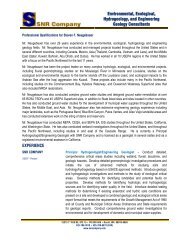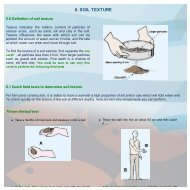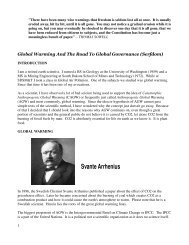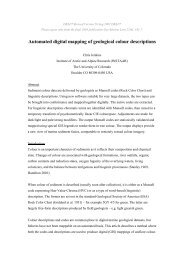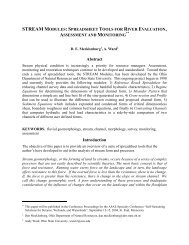ank <strong>of</strong> a large river. From an engineering perspective, it isparticularly important to recognize that analyses, techniques, <strong>and</strong>solutions designed for one scale <strong>of</strong> <strong>stream</strong> may not be directlytransferable to another. Deciding whether an analytical tool,stabilization technique, or <strong>stream</strong> enhancement solution developedfor <strong>stream</strong>s <strong>of</strong> a particular size is transferable across <strong>stream</strong>s atother scales dem<strong>and</strong>s a thorough underst<strong>and</strong>ing <strong>of</strong> theunderpinning science <strong>and</strong> engineering principles involved. It is notenough to have demonstrated repeatedly that a given approachworks when applied to <strong>stream</strong>s <strong>of</strong> a particular scale. Before tools,techniques, or solutions developed in one system scale arepromulgated for wider application, it must be established how <strong>and</strong>why they work. Principles, such as stabilizing a retreating banklineby increasing bank erosion resistance <strong>and</strong> mass stability orretarding near bank velocities, are transferable across differentscales <strong>of</strong> river; however, the hydraulic models, bank stabilityanalyses, <strong>and</strong> structural measures appropriate to control bankretreat successfully may not be scale-independent.3.3 STREAM MORPHOLOGYAlluvial rivers <strong>and</strong> <strong>stream</strong>s are dynamic <strong>and</strong> continuouslychange position, shape, <strong>and</strong> other morphological characteristics inresponse to variations in discharge, sediment load, <strong>and</strong> boundaryconditions. It is, therefore, important to study, not only the existingmorphology <strong>of</strong> the river, but also the possible variations during thelifetime <strong>of</strong> the project. The morphology <strong>of</strong> the river is determined bythe water discharge, quantity <strong>and</strong> character <strong>of</strong> the sediment load,characteristics <strong>of</strong> the bed <strong>and</strong> bank materials (including vegetationeffects), geologic controls, <strong>and</strong> valley topography. Morphologicalchanges <strong>and</strong> adjustments take place in response to variations inany <strong>of</strong> these parameters through time or human activities. Topredict the behavior <strong>of</strong> a river in a natural state or as affected byhuman activities, we must underst<strong>and</strong> how <strong>fluvial</strong> <strong>and</strong> geotechnicalprocesses operate on the boundary materials to form <strong>and</strong> adjustthe morphological features <strong>of</strong> the <strong>stream</strong> through time.A schematic diagram defining the morphological featuresassociated with straight <strong>and</strong> me<strong>and</strong>ering <strong>stream</strong>s is shown inFigure 3.3. The thalweg is the trace <strong>of</strong> the deepest point <strong>of</strong> the<strong>stream</strong>. The thalweg <strong>and</strong> associated line <strong>of</strong> maximum velocitycross from side to side within the <strong>stream</strong>, <strong>and</strong> this pattern <strong>of</strong> flowaffects the overall cross-sectional geometry <strong>of</strong> the <strong>stream</strong>. At abend, there is a concentration <strong>of</strong> flow in the outer half <strong>of</strong> the <strong>stream</strong>due to secondary flow. This causes the scour depth to increase atthe outside <strong>of</strong> the bend, to produce a pool. As the thalwegcrosses the <strong>stream</strong> down<strong>stream</strong> <strong>of</strong> a bend, the velocity distribution<strong>and</strong> cross-sectional shape become more symmetrical <strong>and</strong> scour24 Fundamentals <strong>of</strong> Fluvial Geomorphology <strong>and</strong> Stream Processes
depths decrease due to deposition <strong>of</strong> sediment eroded from thepool up<strong>stream</strong>. This area is known as the riffle or crossing.Figure 3.3 – FeaturesAssociated with Straight <strong>and</strong>Sinuous Rivers (FederalInteragency Stream RestorationWorking Group (FISRWG)1998)Pool-riffle sequences are characteristic <strong>of</strong> cobble, gravel,<strong>and</strong> mixed load rivers <strong>of</strong> moderate gradient (S < 5%) (Sear 1996).Riffles are topographic high points in an undulating bed pr<strong>of</strong>ile <strong>and</strong>pools are low points. Typically, sediment grain size is coarser onriffles than in pools. A sorting mechanism was proposed by Keller(1971) to explain this variation. According to Keller (1971), finesediment is removed from riffles during low flows <strong>and</strong> deposited inpools because velocities <strong>and</strong> bed shear stresses are higher atriffles. As discharge rises, velocity <strong>and</strong> shear stress in the poolincrease quickly, with little, if any increase over the riffle.Consequently at the formative flow, velocities <strong>and</strong> shear stressesin pools are higher than that at riffles, resulting in scour <strong>of</strong> largesediment from the pools <strong>and</strong> deposition on the next riffledown<strong>stream</strong>. However, field evidence for this conceptualexplanation is equivocal. Ashworth (1987), Petit (1987), <strong>and</strong>Clifford (1990) have measured the shear stress reversalhypothesized by Keller, but other studies have suggested that pool<strong>and</strong> riffle velocities equalize at bankfull flow, but do not reverse(Lisle 1979; Carling 1991).Yalin (1971) suggests that pools <strong>and</strong> riffles may beexplained by macro-turbulent eddies generated at the boundaries<strong>of</strong> a straight, uniform <strong>stream</strong> that produce alternate acceleration<strong>and</strong> deceleration <strong>of</strong> flow. Yalin showed theoretically that thelongitudinal spacing <strong>of</strong> faster <strong>and</strong> slower zones would average πw(w = <strong>stream</strong> width) for macro-turbulent eddies with diameterssimilar to the <strong>stream</strong> width. This is about half the riffle spacing <strong>of</strong> 5to 7 times the <strong>stream</strong> width observed in nature (Keller <strong>and</strong> Melhorn1973). Hey (1976) proposed a resolution to this differencebetween theory <strong>and</strong> observation by proposing that the largestFundamentals <strong>of</strong> Fluvial Geomorphology <strong>and</strong> Stream Processes 25



